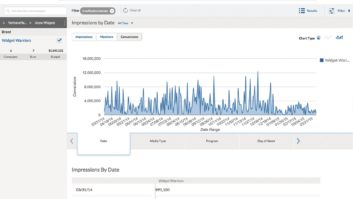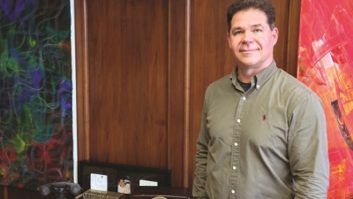The Darling of Internet Go-Go Groups’ Invests Nine Figures in Radio Software Firm
NEWPORT BEACH, Calif: Google’s search for a broadcast technology partner to diversify its online advertising model has led it to purchase an upstart software company founded in 2002 by two brothers interested in developing broadcast technology.
Analysts see Google’s acquisition of dMarc Broadcasting Inc. as the Internet giant’s attempt to expand quickly its advertising distribution services, which include Google’s AdWords ad placement platform and new online streaming video store.
The deal is reported to be worth $102 million in cash plus possible future considerations. dMarc’s founders, brothers Ryan and Chad Steelberg, will remain with the company; Chad Steelberg becomes general manager of Google’s radio division. If the conditions are right, the Steelbergs could wind up billionaires.
‘Complimentary medium’
Google “has been continuously looking for ways to extend the measurable and accountable advertising model that we brought to online space. We think radio is a very complimentary medium to online,” said Josh McFarland, business product manager at Google.
“dMarc is a very good business fit on both the technological level and the team level.”
Google will integrate dMarc’s Revenue Suite inventory buying technology into its AdWords program, McFarland said, and create new radio distribution channels for Google advertisers. dMarc’s technology automatically connects advertisers directly to radio stations, allowing them to schedule and place advertising. dMarc says the technology enables advertisers to purchase and track their ad campaigns more efficiently.
Google’s AdWords platform allows advertisers to buy keywords and deliver targeted ads based on specific searches. Google says clickthrough rates improve when advertising is placed with specific topics.
“In just a few minutes, advertisers can go to our self-serve interface and purchase online advertising. We can now broaden that to other forms of media, specifically radio,” McFarland said.
Analysts say Google has made it clear it plans to extend the technology beyond the Internet. The company is testing a program that allows advertisers to place ads in print in newspapers and magazines, called Google Publication Ads.
“Bundling and getting pieces of ad budgets is what it is all about,” said Bishop Cheen, analyst with Wachovia Capital Markets, covering the media and entertainment sector. “Advertisers like to hedge their bets with a multimedia approach for maximum reach and exposure.
“Google can now bundle up radio, print, Internet and they are working on television. I expect we’ll see much more mixing and matching,” Cheen said.
Media diversification is Google’s strategy, said Peter Geyer, a media analyst at Bond & Pecaro.
“dMarc going to Google is indicative of a paradigm shift in advertising to providing advertisers with an increasing amount of hard data about the results of their investment. The ability to better provide this information will be a primary determinant as to how well radio serves its customers and thus how well radio can maintain rates and revenues,” Geyer said.
“Google is taking their expertise in the pay-for-performance advertising model and endeavoring to transfer that expertise to radio.”
Niche media
Mark Fratrik, vice president of BIA Financial Network Inc., noted the merging of Internet with legacy traditional media.
“Google believes it’s in their best interest to mesh their advertising sales with traditional media advertising to reach an efficiency for their clients. The Internet is a very niche advertising vehicle, and so is local radio in that you target specific age demographics with content,” Fratrik said.
Analysts say one of the key components of the deal was the inclusion of dMarc’s wholly owned subsidiaries Scott Studios and Computer Concepts. dMarc says the pair make it the industry’s largest digital air studio systems vendor with more than 4,600 broadcast users, reaching more than 40 percent of the stations within the top 50 radio groups.
dMarc acquired Scott Studios in 2004 for an undisclosed price. The acquisition gave dMarc instant credibility in the broadcast industry, analysts say.
With that earlier deal, dMarc “immediately became a well-established vendor in the radio marketplace through its subsidiaries Scott Studios and Computer Concepts,” said one source familiar with the acquisition. “It enabled them to get closer to radio stations at the broadcast point.”
dMarc’s Steelberg said his company’s purchase of Scott Studios allowed it quickly to extend a more efficient and accountable radio advertising delivery technology.
“From that point we started the process of connecting those automation systems over the Internet back to our centralized information data center,” Steelberg said. “It certainly was a key part of our ability to launch our ad insertion platform.”
dMarc’s Revenue Suite and its remnant inventory abilities, which typically fills radio stations’ unsold inventory with national advertiser spots, will be enhanced with the integration into Google’s AdWords, Steelberg said.
“We have an advantage in that we can tell what is about to play on a radio station, and then have the contractual and technical capability through our partnership to insert an advertisement specifically targeting the audience for that radio station – and then reporting back on that information because we know exactly when it aired on our automation systems,” Steelberg said.
“We record that spot off the air in the market, then digitize it and send reports back with verification technology in real time over the Internet to the advertisers. They can then modify their ad campaigns in real time.”
Steelberg said more than 500 radio stations in the United States are using Revenue Suite. The platform can interface with broadcast management automation systems besides Scott Studios and Computer Concepts, he said.
Fewer steps
Google sees the new opportunity as a chance to interface with constituents at every level of the advertising industry, including advertisers, agencies and rep firms, McFarland said.
“What we will have eventually is a complimentary platform between individual buyers, agencies and even third parties that represent buyers. We’ll take some steps out of the process and make it all more efficient,” McFarland said.
Analysts say the Google and dMarc marriage will prove beneficial for traditional radio and could prompt Google’s competitors to look harder at diversification.
“I would expect Yahoo! and Microsoft to look at making investments to lever their technological expertise to better serve traditional media, whether it is publishing, cable or broadcasting. Despite all of its hype, the Internet still only accounts for approximately 5 percent of advertising spending,” said Geyer. “That would allow the companies to tap into a much broader stream of mass media advertising spending.”
Wachovia’s Cheen said, “Wall Street’s sentiment has been that if radio is not growing, then it must be dying. Now all of a sudden the darling of the Internet go-go groups comes along and puts its arms around dMarc. I think investors will look at this deal very closely and watch its development.”
Several analysts have questioned whether the Google advertising model will negatively affect national radio rep firms, since advertisers will be able to approach stations directly.
“The nagging question that arises from the non-station side is its possible impact on national reps as a substitute rather than a complement,” said James Boyle, Wall Street analyst and former managing director of Wachovia Capital Markets.
“On the whole, having the 800-pound gorilla of the Internet sit down at the radio table is a net positive at this time; but bear in mind that such creatures take up a lot of room and possess gargantuan appetites.”
Steelberg said dMarc plans to continue to develop ideas and prototypes for RDS and datacasting capabilities, with new products rolling out in late 2006.
dMarc will retain offices in Dallas and Kansas City and combine operations with a pre-existing Google office in Newport Beach, Calif.; dMarc has nearly 100 employees, most of whom will still work for Google, Steelberg said.
Stanford Ph.D. students Larry Page and Sergey Brin founded Mountain View, California-based Google in 1998. The Silicon Valley company employs nearly 5,000 full-time workers and says it’s considered to be the top Web property in most major global markets. The company reported revenues of $1.578 billion for the third quarter ending Sept. 30, 2005.
Google anticipates the acquisition will close in the first quarter of 2006. Executives did not provide additional details regarding the closing.
In addition to $102 million in cash for dMarc’s assets, Google will be obligated to make additional contingent cash payments occasionally if certain product integration, net revenue and advertising inventory targets are met over the next three years. Potential contingent payments could total $1.136 billion over the next 36 months. Google officials declined to discuss specific performance targets.









